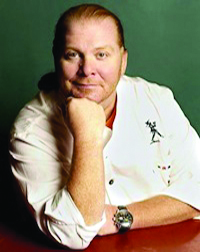We don’t typically think of seafood as seasonal. Some forms of salmon, sea bass, crustaceans and lobster are available in supermarkets year-round.
Traditionally, many species of fish have only been available during certain seasons.
As the world has gotten flatter, it’s become easier to ship product from the East China Sea to New York and back again. Fresh seafood is now accessible all year. But locating and shipping quality seafood increases the cost of the product, as well as its carbon footprint.
Some fish are locally harvested year-round. In New York, we have tilefish and squid in every season. However, migratory fish like bluefish and tuna move up and down the East Coast as the temperature of the ocean water changes, and come through our area only in the spring or summer as they migrate.
I’m a dedicated champion of locally sourced ingredients, and seafood is no exception. If you live in a landlocked area, you don’t necessarily need to omit fish from your diet.
At my restaurants in Las Vegas, for instance, we source our seafood as locally as possible (from the West Coast). Consider your options when purchasing seafood, and use the Monterey Bay Aquarium website to inform you before you head to the market. It is a constantly changing source of information on world fish supplies. (Visit www. montereybayaquarium.org and click on the Seafood Watch icon.
They also have pocket guides and mobile apps you can download.)
Elizabeth Meltz, the director of food safety and sustainability for my restaurants, is an expert on sourcing ingredients locally and on the environmental impact of the alternatives. “I once read something that said, ‘For top-scale flavor, bite when fish are in season,’ and that sums it up,” she says. “Currently, tilefish, shad, mackerel, lobster, skate and flounder here on the East Coast are all in season right now.” For the Gulf Coast and the West Coast, the options are different and easily obtainable.
Soft-shell crabs are one seafood species that is rarely available out of season. What we call “soft-shell” are typically blue crabs that have recently molted their exoskeletons and are still soft and 100 percent edible. In America, they’re available in their natural state and alive from spring to late summer.
In this recipe, I pair the crabs with hot chilies and fusilli bucati. It’s a supremely delicious, seasonal combination.
FUSILLI BUCATI WITH SOFT-SHELL CRABS AND HOT CHILIES
Serves 8 to 10 as an appetizer, 6 as a main course.
6 live soft-shell crabs, “hotel”-sized
Salt and freshly ground black pepper
6 tablespoons extra virgin olive oil
1 medium red onion, thinly sliced
6 Italian frying peppers, cored, seeded, and julienned
4 red jalapenos, cored, seeded, and julienned
1/4 cup dry white wine
2 cups basic tomato sauce (for quick results, try Mario Batali pasta sauces by Gia Russa)
1 1/2 pounds fusilli bucati pasta
Bring 8 quarts of water to a boil in a large pasta pot.
While the water is heating, clean the crabs by snipping off their faces with a pair of scissors and removing the skirts. Cut each crab in half, season with salt and black pepper, and set aside.
In a 12- to 14-inch saute pan, heat the olive oil over medium-high heat until smoking. Add the onions, Italian peppers, and jalapenos, and cook until softened, 8 to 10 minutes. Add the crab pieces and cook until the crabs are deep red and firm. Be careful not to break up the crabs with aggressive stirring. Add the white wine and the tomato sauce, and bring to a boil. Then lower the heat and simmer for 10 minutes.
Meanwhile, add 2 tablespoons salt to the boiling water. Drop the fusilli into the boiling water and cook for 1 minute less than the package instructions indicate. Just before the pasta is done, carefully ladle 1/2 cup of the cooking water into the pan containing the crabs.
Drain the pasta in a colander, and add it to the crab mixture. Toss over medium heat for about 30 seconds, until the pasta is nicely coated. Pour onto a heated platter, and serve immediately.










